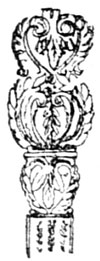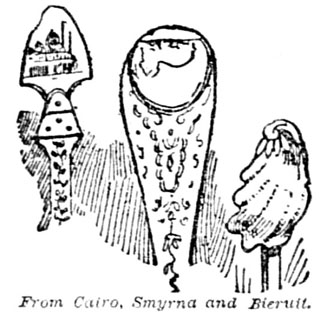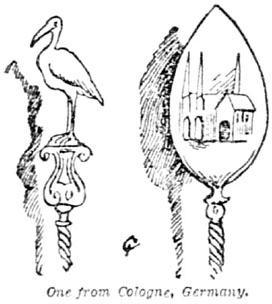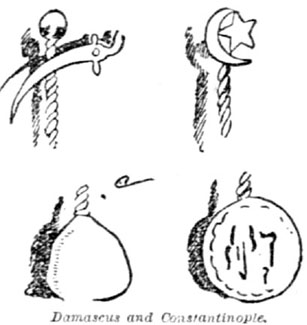quote:
SOUVENIRS FROM THE HOLY LAND.Interesting Reminders Secured by an American Lady.
Spoons From Bible Lands— Adventures and Experiences of the Lady Who Made ths Remarkable Collection.

The fad of the jewelers of a city getting out souvenir spoons of their town is not confined by any means to the United States, as nearly every city and town on the habitable globe has its souvenir spoon.

While traveling through Europe and the Holy Land, luring the spring and summer of 1890, the Rev., Dr. and Mrs. George P. Hays made a collection of spoons that are both curious and beautiful and interesting little, stories are attached to each. There are twenty-one spoons in the collection, one of which is brass, two pewter, and the rest silver, or silver washed in gold. Mrs. Hays highly prizes these spoons as pleasant reminders of her tour and the places visited. Many of them were procured with much difficulty and considerable labor, and several were made to order in cases where the municipality were behind the times and did not boast of a souvenir spoon. In the bowl or on the handle of each spoon is engraved the name of the city at which the spoon was procured and the year. But it is easy to tell the place of origin of the spoon from the carved inscription or image upon it, or its peculiar shape, or the odd workmanship displayed.
The Jerusalem spoon is surmounted with the double or Greek cross, and in its bowl is the name Jerusalem engraved in Arabic.
The Turkish spoon, procured at Constantinople, has the stir and crescent on its top, and for a bowl the monetary unit of the empire— the piaster.
The Damascus souvenir is an odd one. Its handle is topped with the proverbial Damascan blade, suggestive of the Damascus steel, celebrated at one time the world over as the finest steel made, but the art of making which has been entirely lost.
The little spoon from the Egyptian capital is one of the prettiest in the collection. The handle is pounded flat, and from the end to where it meets the bowl is engraved a trailing myrtle. The end is surmounted with a medallion in which is stamped a representation of the finest mosque in Cairo.

The spoon from Beirut, Syria, is of shell design, while Mrs. Hays also managed to secure one from Zohlab, a little Presbyterian mission station in Syria.
The doctor, noted for his readiness to poke fun at anything that li is the semblance of a fad, bought two little pewter spoons at the little mission of Laticea, on the Mediterranean coast and told Mrs. Hays and the other ladies in the party, who were also making a collection, that he "was going to be in the swim" himself. These spoons are much smaller than the tiniest after-dinner coffee-spoons, and would probably be a favorable addition to a doll's kitchen.
From Bethlehem, in the land of Judea, the birthplace of the infant Jesus. Mrs. Hays secured the prettiest spoon of her entire collection. It is carved from a single piece of mother-of-pearl, and is almost flat from end to end, the bowl being hollowed out but little. The carving in the handle is
as fine and delicate as a design in lace, and it looks so fragile that one hates to touch it for fear of breaking it.

Probably the most valued souvenir of the entire number is a common, ordinary little brass spoon which was procured from an old Greek monastery on Mount Tabor. Only three ladies of the Hays party would attempt the ascent of Mount Tabor, and Mrs. Hays was one of the trio. At noon the party reached one of the two monasteries on the mountain. As is their custom, the old monks insisted that the party lunch with them on their frugal repast of meal mixed in oil to form a sort of a pastry porridge, mutton and milk. After luncheon Mrs. Hays asked one of the monks if he would sell a spoon off the table. He replied that he never had sold anything in his life, and lie didn't like to begin now. Determined to have one of those old brass spoons, Mrs. Hays suggested that he give her one, at the same time displaying in her hand two glistening coins with a significance that was not without its desired effect. The "exchange of courtesies" was soon made, and Mrs. Hays now displays her old brass spoon with considerable pride.
Another interesting spoon is the one obtained at Smyrna, Syria. When the ladies went to the only silversmith-shop In the town and asked for a "souvenir spoon" the old merchant was at a loss to know what they meant. They thereupon displayed several that they had procured elsewhere and by this made him understand. One of the ladies, Mrs. Scholey, stepped to the door, and picking up a twig of a fig tree branch, managed to make the old fellow understand that she wanted the handle made an exact reproduction of the little twig. When they went for the spoon a few days after they found that the work had been accurately and beautifully; done, the old man even retaining the twig for a sample and assuring the ladies that they needn't lake the spoons if they didn't suit. The end of the handle is surmounted by a fig leaf, symbolical of the chief Industry of Smyrna— the cultivation of figs. In showing tho old man how they wanted the bowl of the spoon marked they displayed the Athens spoon, in which was engraved in Greek letters, ”Athens, 1890.” In his care and desire to do accurate work the peculiar old Syrian had marked each spoon "Athens, 1890," in Greek letters.



 SMP Silver Salon Forums
SMP Silver Salon Forums

 General Silver Forum
General Silver Forum

 1891 - SOUVENIRS FROM THE HOLY LAND
1891 - SOUVENIRS FROM THE HOLY LAND







